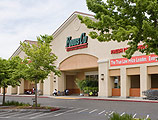“Scotts Valley evacuated. Our Safeway center is shut down,” my partner texted last Friday. That meant four of our shopping centers in Northern California were threatened by wildfires.
The CZU complex fire, the one endangering Scotts Valley and Santa Cruz, remains out of control as of this writing. Another 500 wildfires are burning throughout the state. The Easterners’ lament when they settle in California — “But I miss having real seasons” — is now passé. We have one: fire season. Thanks to global warming, it can begin in July and end as late as mid-November, sometimes later. The Thomas fire in Southern California, the largest single fire ever, broke out on December 4th, 2017. Counting this year, the annus horribilis of the 21st century, three of our last four fire seasons have been utterly devastating.
Those in business may debate climate change over a genteel sherry, but they vote with their wallets. Case in point: We looked at a shopping center for sale in Quincy six weeks ago (a month before fire season started). Quincy is a small town in the Sierra, about a two hour drive north of Lake Tahoe.
I asked a savvy retailer what he thought of the property; he went off in an unexpected direction. “It’s surrounded by hundreds of miles of bone-dry national forest. What if there’s another Camp Fire, like the one that destroyed Paradise? The Paradise Safeway center is still a burned-out shell two years later. Even if the center is spared in a fire, what happens if the Quincy residents who lose their homes don’t rebuild? The center fails.”
However slight the risk, we concurred with his logic and passed on a property that, had it been relatively fire-proof (e.g. set in the immediate Bay Area), we would have pursued hard.
In the old days — before e-commerce — we studied relatively few factors when evaluating a shopping center: its occupancy rate, whether its rents were above or below fair market rent, and its tenants’ health and quality. When e-commerce began decimating retail ten years ago, we added another check: How internet-proof were the tenants? We passed on shopping centers that were vulnerable to e-commerce, those with multiple retailers selling hard and soft goods — clothing stores, hobby shops and the like—concentrating instead on supermarkets, pizza and nail salons.
Now, we’ve added another litmus test: What’s the property’s probable exposure to climate change? Will it flood when the sea level rises or rivers crest their banks? Will it burn when its adjacent forest is aflame? Climate change is truly a national issue — Phoenix hit a staggering 117degrees this week while the Gulf Coast was defenseless before hurricanes Laura and Marco.
Yet California, as always, is unique.
Long before the COVID-19 pandemic, long before our fire season stretched from two months to four, California was losing residents faster than any state but New York. According to U.S. Census data, California’s annual net “out-migration”—departures to other states minus arrivals—averaged 119,000 for the period 2010-2018. Given climate change, our embattled economy, our housing crisis, the intractable homeless issue and, now the threat of punitive new taxes in a state already taxed more heavily than any other, this year’s out-migration may be staggering.
This suggests that our merely tactical approach—avoiding individual properties with climate risks — may be short-sighted. Rather than tactical, perhaps we should be strategic. Sadly, the most compelling strategy would be to cease doing business in California altogether or even to migrate. Steps we’re unlikely to take, but that so many others already have.






















